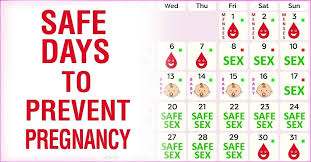Safe Period for Sex: A Comprehensive Guide
Understanding the Safe Period
In this article, we aim to provide you with a comprehensive guide on the safe period for sex. It is important to note that the safe period refers to the time during a woman’s menstrual cycle when the chances of pregnancy are relatively low. By understanding and identifying this period, couples can make informed decisions regarding contraception and family planning.
Calculating the Safe Period
Calculating the safe period requires knowledge of a woman’s menstrual cycle. The menstrual cycle typically lasts for 28 days, with day 1 being the first day of menstrual bleeding. However, it is essential to remember that every woman’s cycle may vary, and irregular cycles can make determining a safe period more challenging.
To calculate the safe period, one must consider the lifespan of both the sperm and the egg. The egg typically survives for up to 24 hours after ovulation, while sperm can live inside a woman’s body for up to 5 days. Based on this information, the safe period can be estimated by subtracting the lifespan of the sperm from the length of the menstrual cycle.
Identifying the Safe Period
Identifying the safe period requires tracking the menstrual cycle and understanding the signs of ovulation. Ovulation refers to the release of an egg from the ovary, which usually occurs around the middle of the menstrual cycle. By tracking the menstrual cycle over several months, patterns can emerge, making it easier to identify the safe period.
Some common signs of ovulation include changes in cervical mucus, a slight increase in basal body temperature, and mild pelvic pain. Additionally, ovulation prediction kits are available in the market, which can help detect the surge in luteinizing hormone (LH) that occurs before ovulation.
Limitations of the Safe Period Method
While the safe period method can be an effective form of natural contraception, it is important to understand its limitations. The method is not foolproof and is less reliable than other forms of contraception, such as hormonal methods or barrier methods.
Factors such as stress, illness, and hormonal imbalances can disrupt the regularity of a woman’s menstrual cycle, making it difficult to accurately predict ovulation. Additionally, the lifespan of sperm and the timing of ovulation can also vary, further reducing the reliability of this method.

In conclusion, understanding the safe period for sex is crucial for couples who wish to practice natural contraception or plan their family. While the safe period method can provide an estimate of when the chances of pregnancy are low, it is essential to remember its limitations and consider alternative forms of contraception for greater reliability.
Safe Period for Sex – Frequently Asked Questions
1. What is the safe period for sex?
The safe period for sex refers to the time during a woman’s menstrual cycle when she is least likely to get pregnant. It is generally considered to be the days before and after ovulation when the chances of conception are lower.
2. How can I calculate my safe period?
The safe period can be calculated by tracking your menstrual cycle and identifying the days when ovulation is likely to occur. This can be done by using various methods such as calendar-based calculations, monitoring basal body temperature, or using ovulation prediction kits.
3. Is the safe period method effective for contraception?
The safe period method is not considered a reliable form of contraception. While the chances of getting pregnant are lower during the safe period, there is still a risk of unintended pregnancy as sperm can survive in the female reproductive system for several days.
4. Can I rely solely on the safe period method to avoid pregnancy?
No, it is not recommended to rely solely on the safe period method for avoiding pregnancy. If you want to prevent pregnancy, it is advisable to use more reliable methods of contraception such as condoms, hormonal birth control, or intrauterine devices (IUDs).
5. Does the length of the menstrual cycle affect the safe period?
Yes, the length of the menstrual cycle can affect the safe period. Women with shorter menstrual cycles may have a shorter safe period, while those with longer cycles may have a longer safe period. It is important to track your own cycle to determine the specific safe period.
6. Can I get pregnant during my period?
While it is less likely to get pregnant during your period, it is still possible. Sperm can survive in the female reproductive system for up to 5 days, so if you have a short menstrual cycle, it is possible for ovulation ovulation can occur7. Can I have unprotected sex during the safe period?
While the chances of getting pregnant are lower during the safe period, it is still advisable to use contraception if you want to avoid pregnancy. Unprotected sex always carries a risk of pregnancy and sexually transmitted infections.
8. Can the safe period method be used to conceive?
Yes, the safe period method can be used to increase the chances of conceiving. By tracking your menstrual cycle and identifying the most fertile days, you can plan intercourse accordingly to maximize the chances of getting pregnant.
9. Does breastfeeding affect the safe period?
Breastfeeding can affect the safe period as it can delay the return of regular ovulation. However, it is not a reliable method of contraception, and if you want to prevent pregnancy, it is best to use other forms of birth control.
10. Are there any other methods of contraception that can be used alongside the safe period method?
Yes, it is advisable to use additional methods of contraception alongside the safe period method to increase effectiveness. Condoms, hormonal birth control, and barrier methods can provide added protection against unintended pregnancy.




